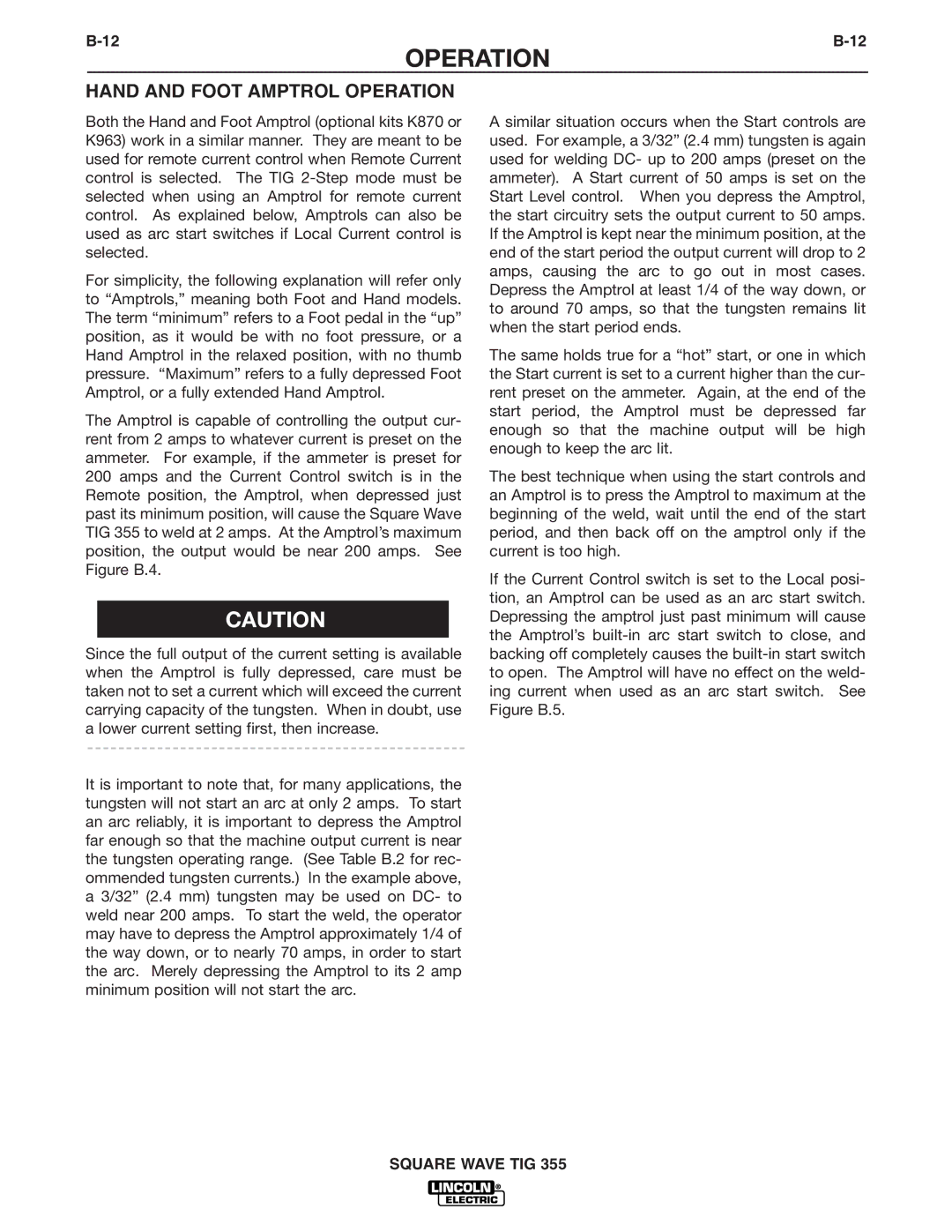
OPERATION
HAND AND FOOT AMPTROL OPERATION
Both the Hand and Foot Amptrol (optional kits K870 or K963) work in a similar manner. They are meant to be used for remote current control when Remote Current control is selected. The TIG
For simplicity, the following explanation will refer only to “Amptrols,” meaning both Foot and Hand models. The term “minimum” refers to a Foot pedal in the “up” position, as it would be with no foot pressure, or a Hand Amptrol in the relaxed position, with no thumb pressure. “Maximum” refers to a fully depressed Foot Amptrol, or a fully extended Hand Amptrol.
The Amptrol is capable of controlling the output cur- rent from 2 amps to whatever current is preset on the ammeter. For example, if the ammeter is preset for 200 amps and the Current Control switch is in the Remote position, the Amptrol, when depressed just past its minimum position, will cause the Square Wave TIG 355 to weld at 2 amps. At the Amptrol’s maximum position, the output would be near 200 amps. See Figure B.4.
![]() CAUTION
CAUTION
Since the full output of the current setting is available when the Amptrol is fully depressed, care must be taken not to set a current which will exceed the current carrying capacity of the tungsten. When in doubt, use a lower current setting first, then increase.
It is important to note that, for many applications, the tungsten will not start an arc at only 2 amps. To start an arc reliably, it is important to depress the Amptrol far enough so that the machine output current is near the tungsten operating range. (See Table B.2 for rec- ommended tungsten currents.) In the example above, a 3/32” (2.4 mm) tungsten may be used on DC- to weld near 200 amps. To start the weld, the operator may have to depress the Amptrol approximately 1/4 of the way down, or to nearly 70 amps, in order to start the arc. Merely depressing the Amptrol to its 2 amp minimum position will not start the arc.
A similar situation occurs when the Start controls are used. For example, a 3/32” (2.4 mm) tungsten is again used for welding DC- up to 200 amps (preset on the ammeter). A Start current of 50 amps is set on the Start Level control. When you depress the Amptrol, the start circuitry sets the output current to 50 amps. If the Amptrol is kept near the minimum position, at the end of the start period the output current will drop to 2 amps, causing the arc to go out in most cases. Depress the Amptrol at least 1/4 of the way down, or to around 70 amps, so that the tungsten remains lit when the start period ends.
The same holds true for a “hot” start, or one in which the Start current is set to a current higher than the cur- rent preset on the ammeter. Again, at the end of the start period, the Amptrol must be depressed far enough so that the machine output will be high enough to keep the arc lit.
The best technique when using the start controls and an Amptrol is to press the Amptrol to maximum at the beginning of the weld, wait until the end of the start period, and then back off on the amptrol only if the current is too high.
If the Current Control switch is set to the Local posi- tion, an Amptrol can be used as an arc start switch. Depressing the amptrol just past minimum will cause the Amptrol’s
SQUARE WAVE TIG 355
